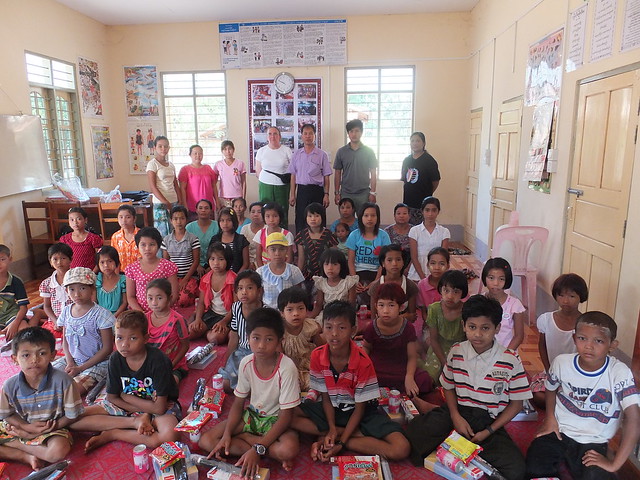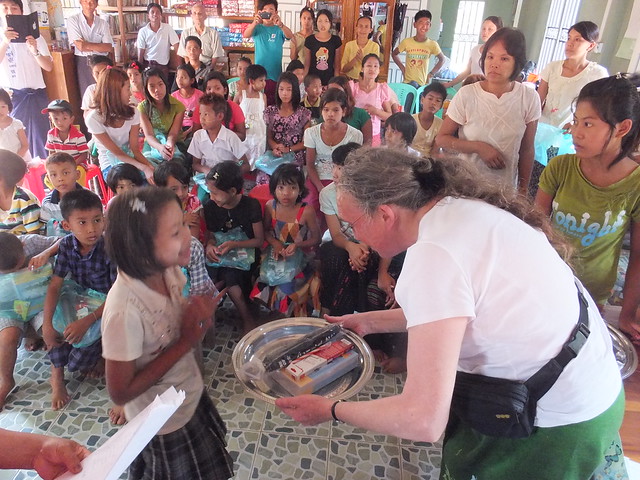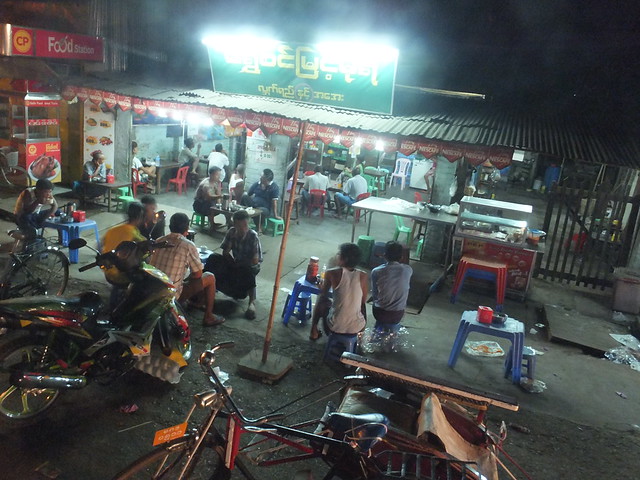skip to main |
skip to sidebar
Events of Tuesday 22nd April 2014
Click on any picture below for an uncropped image.
Only slightly revived by a couple of hours sleep at Mawlamyine, I prepared for our departure. We briefly met the Organiser's husband. He was a professional writer on archaeology and history and had just been discharged from hospital. He graciously gave me a copy of his latest work on Mon History.
It’s important to realise that early Burmese history was the history of a number of distinct ethnic groups who could be quite belligerent. Various kings attempted to unify the warring tribes and, when the British took over, they considered the problem solved which, of course, it wasn’t. The exploits of the Japanese in Burma during WWII probably did more to unify the various factions than any previous event. Mon National Day was created after the conclusion of WWII and, when the British granted independence in 1948, the Union of Myanmar specifically recognised the existence of these ethnic groups. For more information, try Wikipedia here.
Mon State, remote from the centre of the land mass, seems to suffer from the problem that in England is called “the North-South Divide”. It is, in general, poorer and in greater need of assistance. We were to visit the network of Drop In Centres (DICs) which are supported by Dr. Hla Tun.
First call was to the ‘Largest Reclining Buddha in the World’ which I’d visited before (there's a report here). There was a network of scaffolding around the head to facilitate maintenance. There’s a second, even larger, Buddha image being constructed on the other side of the valley – it hadn’t obviously changed a lot since my previous visit.
Then it was on to our first Drop-In Centre (DIC) at Kot Kha Pon, this one supported by aid from the Government of Australia and the Care International charity. The Doctor and his son distributed a folding umbrella and various items of stationery to the young people. The D.I.C. has a PC Computer and a treadle-operated sewing machine. A donation of cash was made to the volunteers whose time is essential to the running of the DICs.
 Kot Kha Pon Drop In Centre.
Kot Kha Pon Drop In Centre.
We then made our farewells and moved onto another DIC at Nyaung Kyo Mae. Again, there was a PC Computer and Sewing Machine. There was also a television set, I think arranged for playing videos. The Doctor made a donation of cash to students who are being assisted through Government Schools. Jan then assisted in distributing an umbrella and stationery to all the children.
 The distribution in progress at Nyaung Kyo Mae Drop In Centre.
The distribution in progress at Nyaung Kyo Mae Drop In Centre.
The next DIC was at Ka Mar Wet. All the umbrellas and stationery had already been selected into individual piles, ready for distribution.
 Jan assisting with the distribution at Ka Mar Wet.
Jan assisting with the distribution at Ka Mar Wet.
We then drove to Ko Dut, where we would sleep overnight in the DIC, prior to making distributions the following morning.
My Pictures
Kot Kha Pon Drop In Centre.
Nyaung Kyo Mae Drop In Centre.
Ka Mar Wet Drop In Centre.
Ko Dut Drop In Centre.
More
Next Post describing this trip.
[Revised 13-May-2014, pictures added 20-May-2014]
Events of Monday night/Tuesday morning 21st/22nd April 2014
Dr. Hla Tun had said he’s pick me up at 7.30 p.m. to go for dinner at his house. Because of my fragile state, I was reluctant to be too ambitious but I nibbled some food before the doctor, his son and I drove downtown to where our P.T.T. bus to Mawlamyine was due to leave at 9.00 p.m.
Apart from out personal luggage, we were taking various heavy cartons of some of the items to be distributed on our visits, which all had official ‘P.T.T.’ luggage labels attached.
 The Coach.
The Coach.
The coach seating was 2+1 and we had a complete row with the doctor and his son on the left of the aisle and me on the right. We set off a few minutes after nine and made fairly slow progress leaving the city. The sky was completely dark but the lights on the almost continuous chain of houses, shops and tea houses lining our route illuminated the apparently innocuous night life of the city.
 A Tea House on the road out of Yangon.
A Tea House on the road out of Yangon.
It was clear than we were following the road through Bago and Kyaikto to Mawlamyine, which I’d taken (in the opposite direction) returning from Mawlamyine on an earlier trip. Crossing a broad waterway, I looked immediately to my left and had a decent view of the Rolling Lift Bridge I’d commented on on my earlier trip (Bago to Kyaikto by Train).
After about four hours, we passed through Kyaikto and shortly the bus pulled into the car park of the large restaurant I’d seen on my earlier trip. At 1 o’clock in the morning, the place was thronged as there were already about four buses parked. My priority was a visit to the washroom then I had a cup of sweet tea with the Doctor and his Son, who were ready for more substantial food.
Our stop was less than half an hour and then we continued south. I think it was only around two hours later when we rumbled onto the long road and rail bridge which has transformed access to the south of Myanmar.
The bus took the main road through Mawlamyine furthest away from the sea and came to a stop at the brightly-lit bus office. We got off and retrieved our luggage, as did other passengers. By the time we were clear of the bus other passengers were boarding and, with a new driver, the bus departed but I didn’t find out the destination although I imagine it was further south.
We had a few minutes to wait in the oppressive heat of the night before the People Carrier which Dr. Hla Tun had arranged turned up. The we loaded everything aboard and set off inland towards to suburbs. The Doctor explained that the Orphans and Vulnerable Children (OVC) Project organiser for Mon State had offered to let us sleep at her house for a few hours until morning. However, our driver had trouble finding the address despite the Doctor phoning the lady and seeking “better and further particulars”. We eventually arrived when the lady walked from her house to the nearest junction, to direct our wandering People Carrier.
br>
The house was modern and brick built with the main room occupying the full width of the building approached from outside by a couple of steps (where footwear is discarded). There was a modern ceiling with a raised section featuring various electric light fittings and a polished parquet floor. A passage led towards the rear of the house, with partitioned sections left and right providing various bedrooms. This passage then opened out into a complex of kitchen, W.C. and Shower Room.
The intention had been to set out bedding (and mosquito nets) in the large main room for us all but they decided to set up two beds like this for the Doctor and his Son, giving me one of the bedrooms which I think involved turfing one of the daughters out of her room in the middle of the night. There was a simple raised bed with a mosquito net and the top of the small storage unit certainly contained a girl’s beauty products, including a large disk for Thanaka grinding. Thanaka is the white cream still applied by most girls and young boys intended as a sunscreen and beautifier. Personally, I find it rather astringent and uncomfortable.
I quickly collapsed into the bed but I only had a couple of hours before it was time to set off further south by car – Mawlamyine was only a ‘staging post’ to the parts of Mon State we were to visit, accompanied by the OVC Organiser.
This was to be my first visit to see for myself the work of the OVC Project, but there are earlier reports on the visits made by Dr. Hla Tun in 2013 here and in 2012 here.
My pictures
Mawlamyine - Yangon by Coach.
Rest Stop at Mawlamyine.
More
Next Post describing this trip.
 Kot Kha Pon Drop In Centre.
Kot Kha Pon Drop In Centre.
 The distribution in progress at Nyaung Kyo Mae Drop In Centre.
The distribution in progress at Nyaung Kyo Mae Drop In Centre.
 Jan assisting with the distribution at Ka Mar Wet.
Jan assisting with the distribution at Ka Mar Wet.


